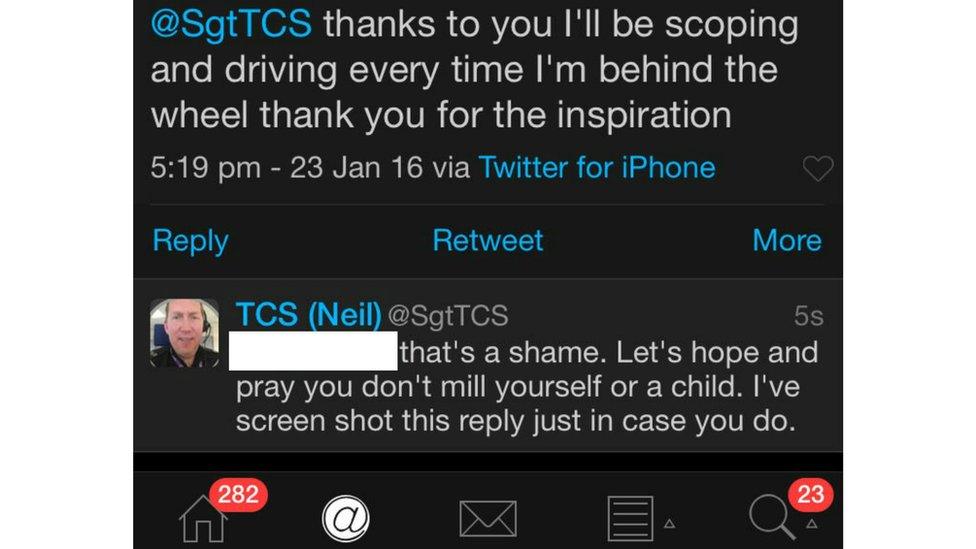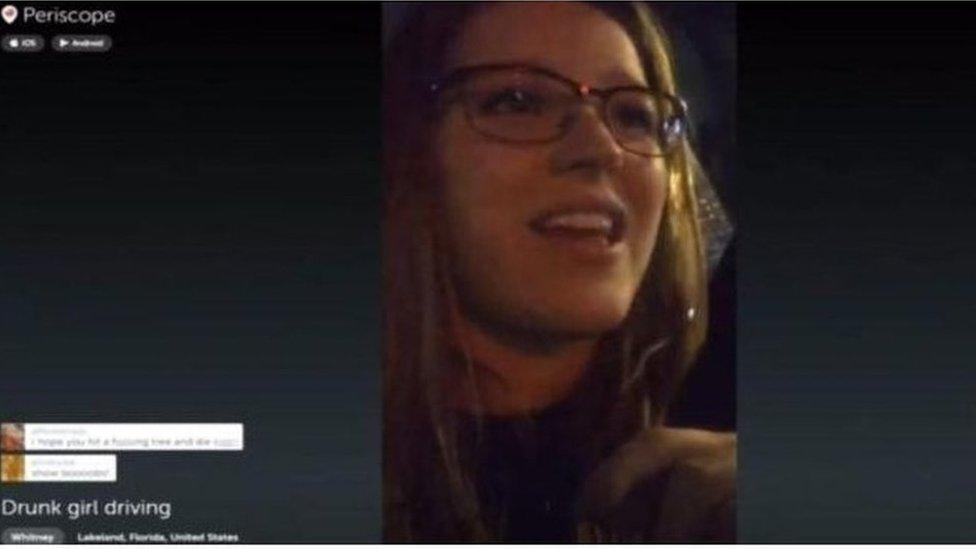The danger with streaming and driving
- Published
Neil sits in a driving simulator
A police officer is running an unofficial social media campaign to stop people streaming and driving. How dangerous is this fad?
Neil is a serving police sergeant, a prolific Twitter user, and today he's a very dangerous driver. He is in a dark blue hatchback and the speedometer is edging over 70mph. There are motorway bridges, slower traffic zooms past and recedes into his rear view mirror, and Neil has deliberately taken his eyes off the road.
While he is driving Neil records video on a smartphone stuck to the windscreen. As he records he looks at the phone and not the motorway, and the car drifts dangerously out of the lane.
Fortunately for other road users, Neil is in the Digi-car at the Transport Research Laboratory in Berkshire. It is a driving simulator, and Neil is using it to demonstrate the effect of streaming and driving in a way that does not endanger other motorists.
Neil, who does not want to give his surname, is also known as @SgtTCS on Twitter, external and is the organiser of an unofficial online campaign called #dontstreamanddrive, which aims to discourage people from recording or streaming video from their mobile phones while driving.
Racing driver Lewis Hamilton recently attracted criticism for a post on social app Snapchat in which he appeared to record a video-selfie on his phone while riding a motorbike in New Zealand. And there are plenty of non-celebrities doing the same and sharing on social media.
As the numbers live streaming grow, the #dontstreamanddrive campaign wants people to know driving while streaming can be unsafe.

Neil replies to people on Twitter to teach them about the dangers of streaming and driving
Neil noticed that increasing numbers of people were live streaming on the Periscope app from their phones while behind the wheel. Other drivers were recording video-selfies using apps like Snapchat and posting them online.
"I've seen several broadcasts where in their commentary they say: 'I'm in the car and I'm driving and I'm scoping and it's probably really illegal, but I'm a safe driver so we should be OK.' They're not OK. If you are a streaming driver you're not a safe driver because fundamentally your attention isn't where it should be."
He is particularly concerned about the opportunities for interaction some apps provide - he has spotted drivers not just performing for the camera but responding to comments.
"Some people who I've observed are into the social media celebrity status and they want to be popular," he says. "In some cases they're singing, doing little performances." Others want to communicate with their audience: "You can see them reading the comments - you can see their eyes are off the road."
Where the drivers seem to be based in the UK, Neil has occasionally referred the videos to local police forces for investigation. If they are not touching the phone, he says, it's not a mobile phone offence, but if they're driving dangerously other offences may apply. "Driving without due care and attention, not in proper control of the vehicle, dangerous driving, and if the consequences are fatal - death by dangerous driving," he says.
In other cases he replies to them on Twitter to ask them to consider what they are doing.
In Hamilton's case police in New Zealand said there was insufficient evidence to take any action, and his team declined to respond to a BBC request for comment. "I have tried to contact him on Twitter to see whether he wants to join the campaign and do something for road safety - he hasn't replied to me yet," Neil says.
At the Transport Research Laboratory, Neil's efforts to record video while driving had a clear effect on his safety. Watching from a nearby control room Prof Nick Reed, observes that Neil strayed out of lane compared with an earlier drive where he wasn't streaming and driving. His reaction times also worsened. "It would be the difference between having an accident and avoiding an accident, or the difference between a fatal accident or an injury-only accident," says Reed.

This Florida woman was charged after streaming herself drink driving on Periscope
There are no specific figures for the risks of streaming mobile video while driving, but mobile phone use is well known to be dangerous. According to Reed, the reaction times of people using their phones are "worse than being at the legal limit for alcohol".
Official figures show that using mobile phones while driving accounted for 21 fatal accidents in 2014. Currently there is a consultation on the introduction of stiffer penalties for people using hand-held mobiles.
Alice Bailey, from the road safety charity Brake, says she would like to see those penalties increase and that she supports #dontstreamanddrive. "You're actually three times more likely to crash if you do a second complex task while you're driving," she argues.
The Department for Transport advice on streaming and driving is this: "The message is clear - keep your eyes on the road, not on your phone, or you could end up being banned from the road."
Neil's unofficial campaign has attracted support from police and road safety Twitter accounts across the country, as well as plenty of ordinary drivers, cyclists and pedestrians. He hopes in the end that the reaction on social media may help make streaming and driving socially unacceptable.
Subscribe to the BBC News Magazine's email newsletter to get articles sent to your inbox.